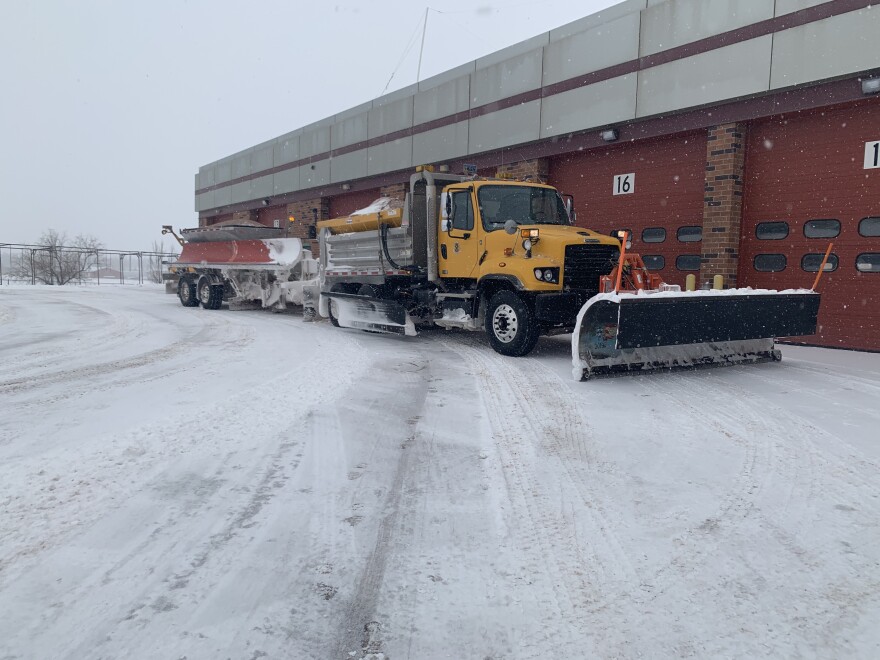I'm riding shotgun in Randy Okray's snow plow. He's the Gillette maintenance crew leader for the Wyoming Department of Transportation (WYDOT). Okray is clearing up Interstate 90.
"This route actually goes out just past the Campbell County/Johnson County line. Then there's a cross, and then we come back into Gillette," Okray says.
The cab of the truck is warm, so warm Okray has taken off his coat. The windshield whippers are going to prevent too much ice caking on the windshield.
"Even though the road has already been plowed this morning, you'd never know. In most places, you can't see the concrete," he says. Okray is driving a tow plow, which means there's a blade on the front, then a trailer swings from behind with another plow so it can clear both lanes. We've already turned around and are heading back to Gillette when he gets a phone call.
"Right where we turned around, somebody got hit," Okray says into his cell phone. The plow driver coming from Buffalo, just a few miles from us, was rear-ended by a car. This has been a common occurance lately. In fact, this year's drivers may have set a modern-day record, crashing into snow plows 21 times since October. WYDOT Public Information Officer Doug McGee says this season is unlike any other.
"From 2018 to 2019, which would have been last season, there were eight snow plow strikes. The season before that there were eight strikes. And the season before that there were three," he says.
WYDOT's winter season runs from October through April. McGee says these incidents tend to happen on major interstates like I-80 and I-90 more so than on state highways.
These collisions tend to have a common theme, Okray says.
"Most of the time its speed, you know visabilities are low. A lot of times roads are pretty slick so stopping distances aren't what they used to be," he says.
A snow plow usually is chugging along at 35 miles per hour, depending on the conditions. As they plow, the trucks also create a snow cloud that brings white-out conditions around the truck.
"So when they come up on those they're going a little too fast and they have trouble stopping and the snow cloud kind of gets them. The visibility drops," Okray says.

As he continues to plow, Okray points out that cars have started lining up behind us. I can see a semi-truck poking out above the trailer in my side mirror. Since the plow is taking up two lanes, vehicles aren't able to speed past.
"The reason they're able to catch up a lot of times is because the roads are better behind us than in front of us. So a lot of times people get frustrated being behind a plow, but it's actually a lot better behind us than in front of us or we wouldn't be out," he says.
WYDOT hasn't found a direct reason for why there's a sudden increase this season. But Doug McGee has a few theories.
"We're seeing more snow this year and more and longer wind events. So that's creating a lot more plowing needs. So by default it's possible one contributing factor is that our plows are just out there more often," he says.
McGee says there's no singular thing contributing to the spike. But when there is a collision with a snow plow, it can go beyond injuries.
"Of course the other issue is that more than likely our plow is put out of service. In some cases, the plow is damaged beyond repair... It takes time and money to get that plow up and running for the citizen so at the very least it can cause delays in service," he says.
WYDOT says insurance has paid more than $93,000 over three years for claims for snow plow damage. Though that amount doesn't include every claim filed for each accident.
So what's the solution?
First, try and slow down.
Laura Dalles, public involvement specialist with WYDOT District 4 in Sheridan, says if drivers can't completely see in front of the plow it's probably a better idea to stay behind.
"Follow from a safe distance, which is typically double what you'd usually follow a vehicle from. Drop your speed, take your time. There's a reason there's a snow plume, it's because there's snow in front of the snow plow. So if the snow plow, if you can't see, don't pass. It's just common sense there," she says.
WYDOT plows are also dropping sand, de-icing chemicals other things to create better traction. So Dalles says staying an appropriate distance will also protect cars.
McGee says WYDOT will continue to try and alert the public to this issue through social media and press releases about safety and accidents. But in the wake of the sudden increase in accidents, WYDOT is trying something new.
"Our overhead signs, which we called dynamic message signs, or we commonly call DMS. We just started adding messages to the DMS that plow activities are ahead, drive cautiously, that sort of thing. So giving people on the road an immediate and direct message to expect to see a snow plow ahead and hoping that will grab their attention and hopefully be a little more alert," he said.
WYDOT has one final piece of advice: Don't crowd the plow!
To find out about road conditions before and during travel, WYDOT recommends using its 511 service, which can be used over the phone, online or through an app.
Have a question about this story? Contact the reporter, Catherine Wheeler, at cwheel11@uwyo.edu.








